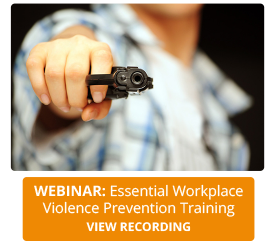We live in dangerous times. Increasingly, violence erupts in the workplace. This is a frightening, uncomfortable issue. Yet there are measures you can take — today — to protect your people and your company.
Preventing violence requires a proactive approach. Don’t get caught off guard. Take the steps below to lower the chances of a tragedy occurring in your place of business.
What You Need to Know
1. Workplace violence is a pressing issue.
“Homicide is currently the fourth-leading cause of fatal occupational injuries in the United States ... Nearly 2 million American workers report having been victims of workplace violence each year. Unfortunately, many more cases go unreported.” - OSHA
Workplace violence impacts your business.
2. Violence can come from any source, whether that be the actions or words of another employee or a personal situation that leaks over into an employee’s professional life. Acts of aggression may come from outside parties who, for a variety of reasons, are unsatisfied with a decision your organization has made.
In short, violence can arise from internal or external situations.
3. There is a spectrum of violence. You must distinguish between empty and real threats. Not all threats translate into violent action. Careful consideration of all threats and potential violence now will save you stress and resources later.
“Determining which threat to take seriously, which is just venting or which is a hoax is part experience, part intuition and part luck.” - Nonprofit Risk Management Center
4. Employees must feel safe in order to perform at optimal levels. Employees need to know that you, as a manager or employer, value their safety. They need to see that you have put in all reasonable effort to secure their safety.
Keeping Your Employees Safe
1. Define what constitutes violence in your organization. Comprehending violence requires a nuanced understanding. What one person takes as a joke another will consider harmful.
Define, specifically, what your organization regards as acts of violence — what forms violence takes for the purpose of your related policies. This will prevent confusion later on.
2. Develop anti-violence policies. Clarify what violence — from verbal threats to physical actions — looks like. Cover the use of weapons. Explain how specific situations should be handled. Use detailed and exact wording.
Don’t leave any wiggle room in your organization’s safety policies. Create firm policies which leave no room for toleration of violence.
The key is to follow and enforce your policies at the first sign of trouble. Investigate and resolve problems in a timely manner. Swift action can prevent a problem from exploding into a violent incident.
3. Have employees practice your safety procedures and protocols. Expanding the safety chapter of your organization’s handbook is a noble effort, but policies never read and never practiced do little good.
Make sure all employees understand (and follow) your safety policies. All staff should know what constitutes acceptable and unacceptable behavior.
4. Educate all staff on how to handle violent situations. The right skills and knowledge can diffuse an intense situation, but an unwary word or action can create a tragedy.
5. Maintain open communication with your managers about potential threats. Did you receive a strange call? Did an ex-employee make a threat? Tell your leadership team. Alert your managers to sources of potential danger, as known threats are easier to prepare for.
6. Know your state’s related laws. Many states have laws covering workplace violence. One example is the North Carolina Workplace Violence Prevention Act. This is legislation which allows an employer to seek a no-contact order for a consenting employee who has experienced harassment or violent threats (according to the Poyner Spruill law firm).
Such laws can be valuable tools for protecting your employees.
7. Secure the premises. Invest in security technology for vulnerable areas of your property. This includes cameras, alarms, lights, and more secure locks.
8. Get outside help when needed. Some situations call for police assistance or the intervention of specialized services. If a situation is serious, be willing (and quick) to call the police or to obtain outside help.
Watch for Warning Signs
Certain traits or behavioral changes can indicate trouble. Use warning signs to help you spot potential danger — before it strikes.
(Note: Personal feelings or prejudice can influence perception. Make sure any reported warning signs are based on true safety concerns before taking action.)
1. Note sudden and radical changes in behavior. As Forbes points out, an introvert who suddenly becomes an extrovert, or a quiet employee who transforms into an angry, complaining individual may be on a dangerous road.
2. Antisocial behavior or withdrawal from others can be a warning.
3. Look out for people who blame others or the world for all their problems. Such people may also blame the victims in tragedies on the news.
4. The excessively paranoid and people with dark obsessions (such as weapons) may be mentally unstable and capable of rash acts.
5. A negative life event, such as getting fired, can push some people over the edge. Especially if those individuals exhibit other warning signs (according to Entrepreneur).
6. Does a new hire have a violent history or a criminal past? Beware. A troubled history can be an indication of future risk and potential liability issues.
7. Threats — The most serious sign of all. People who habitability make threats are halfway down the path of realization.
Preventing violence in your organization is an ongoing process, and one hundred percent prevention is impossible. But, with common-sense precautions and proper procedures, you can lessen the potential for tragedy. After all, nothing matters more than the safety of your organization.


